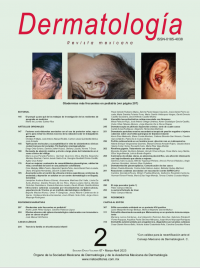Socio-labor factors associated with the use of sunscreen, clothing or a hat to avoid the harmful effects of solar radiation on Peruvian workers.
Dermatol Rev Mex. 2023; 67 (2): 147-154. https://doi.org/10.24245/drm/bmu.v67i2.8741
Christian R Mejía,1 José Antonio Alanya-Ricalde,2 Carmen Jesús Quintanilla-Muñoz,3 José Armada4
1 Centro de Investigación en Medicina Traslacional, Universidad Norbert Wiener, Lima, Perú.
2 Universidad Andina del Cusco, Cusco, Perú.
3 Hospital Regional del Cusco, Cusco, Perú.
4 Universidad Continental, Huancayo, Perú.
Resumen
OBJETIVO: Determinar los factores socio-laborales asociados con el uso de protector solar, ropa o gorro para evitar los efectos nocivos de la radiación solar en trabajadores peruanos.
MATERIALES Y MÉTODOS: Estudio transversal, analítico, de análisis de datos secundarios, efectuados en 2016 en las ciudades más importantes de Perú. Las variables estudiadas fueron el uso de tres implementos para evitar la radiación solar en trabajadores peruanos, estas variables fueron: el uso de protector solar, ropa especial o gorra usada durante su trabajo; las variables se asociaron con variables socio-laborales mediante estadística analítica.
RESULTADOS: Se incluyeron 1299 trabajadores encuestados. Los trabajadores de salud (49%), los técnicos (36%) y los que trabajan en arte (36%) fueron los que menos usan protector solar (valor p < 0.001). En el análisis multivariado, los que usaban con más frecuencia protector solar tenían un familiar con cáncer de piel (p: 0.014) y tenían más horas de exposición al aire libre durante su trabajo (p: 0.001). Usar ropa protectora fue menor entre los que trabajaban más horas al aire libre (p: 0.001). En comparación con otras profesiones, se encontró que usaban más gorro los de salud (p: 0.006), los de actividades sociales (p: 0.043), los de ingeniería (p: 0.001) y los de actividades políticas (p: 0.027), en cambio, los que tenían otras profesiones usaban menos gorro que los de seguridad (p: 0.049).
CONCLUSIONES: Se encontraron diferencias en el uso de medios de protección según la profesión, lo que se asocia con múltiples variables.
PALABRAS CLAVE: Protector solar; cáncer de piel; Perú.
Abstract
OBJECTIVE: To determine the socio-labor factors associated with the use of sunscreen, clothing or a hat to avoid the harmful effects of solar radiation on Peruvian workers.
MATERIALS AND METHODS: Cross-sectional analytical study of secondary data analysis performed in 2016 in the most important cities of Peru. The main variables were the use of three implements to avoid solar radiation in Peruvian workers: The use of sunscreen, special clothing, or a cap worn during their work; associating them with socio-labor variables using analytical statistics.
RESULTS: There were included 1299 workers surveyed. Health workers (49%), technicians (36%) and those who work in art (36%) were those who least used sunscreen (p value < 0.001). Health workers (49%), technicians (36%) and those who work in art (36%) were those who used sunscreen the least (p < 0.001). In multivariate analysis, those who used sunscreen more frequently had a family member with skin cancer (p: 0.014) and had more hours of outdoor exposure during their work (p: 0.001). The wearing of protective clothing was lower among those who worked more hours outdoors (p: 0.001). Compared to other professions, it was found that health workers (p: 0.006), social activities (p: 0.043), engineering (p: 0.001) and political activities (p: 0.027) wore more caps. on the other hand, those from other professions wore fewer hats than those from security (p: 0.049).
CONCLUSIONS: Differences were found in the use of protection means according to profession, being associated with multiple variables.
KEYWORDS: Sunscreen; Skin cancer; Peru.
Recibido: febrero 2022
Aceptado: septiembre 2022
Este artículo debe citarse como: Mejía CR, Alanya-Ricalde JA, Quintanilla-Muñoz CJ, Armada J. Factores socio-laborales asociados con el uso de protector solar, ropa o gorro para evitar los efectos nocivos de la radiación solar en trabajadores peruanos. Dermatol Rev Mex 2023; 67 (2): 147-154.

